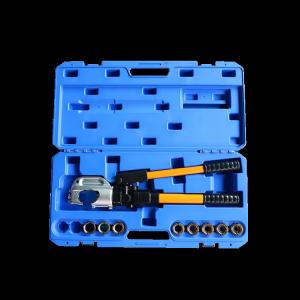
Add to Cart
Hydraulic crimping tools is a professional tool for crimping copper and aluminum lugs with different types, a wide range of crimping dies from 4-1000mm^2 to suit for different demand. The main crimping shape is hexagonal, special shape design is provided.
1. Design to accommodate hexagonal, dies of hydraulic tools for applying compression fittings too copper, aluminum conductors.
2. Two stage pumping action for rapid ram advance to the connector hold position with minimum pumping action.
3. Automatic retraction when the pressure of crimper tools reaches 700kg/cm2 reached.
4. The glass fiber operation insulates the stick, the crimping tool can bear the electric voltage 200KV, keeping on the minute.
5. Hydraulic tools with 180 degree rotatable head.
6. The pressure of the hydraulic tools outside the body adjusts to press the valve.
Model:EP-430(Safety valve inside)
The EP-430 12 Ton Wire Crimper is a manual hydraulic crimping tool designed to ensure high-performance crimping of electrical wires and terminals, especially for cables up to 300mm². Below is a step-by-step guide on how to use this tool safely and effectively:
Check the Tool: Before use, inspect the crimper for any visible damage, such as cracks or wear. Ensure the hydraulic system is intact, and the crimping jaws are free of debris.
Select the Correct Die: The EP-430 comes with different crimping dies. Choose the appropriate die that matches the cable size and terminal you’re working with. For example, use the die for 300mm² cables if you're working with large wires.
Ensure Proper Cable and Terminal: Ensure the wire size and terminal type are compatible with the crimping tool. The tool is designed for 300mm² cables, so use cables within this range to achieve the best results.
Place the Die: Open the crimping jaws and insert the appropriate crimping die into the tool. The die should fit snugly in place to ensure a proper crimp.
Position the Cable: Insert the stripped end of the wire into the crimping die, ensuring the terminal is positioned correctly around the wire. The wire should be fully inserted, and the terminal should be aligned properly to ensure a secure crimp.
Hydraulic Pump Operation:
Hold the handle of the EP-430 firmly and begin to operate the hydraulic pump by pressing down on the handle.
As you press the handle, the hydraulic system will gradually close the crimping jaws, compressing the terminal onto the wire.
Ensure that the pressure is applied slowly and steadily, as rapid pumping could cause uneven crimps or damage to the tool.
Crimping Action:
Continue to pump the handle until the jaws have fully compressed the terminal and the wire.
Most hydraulic crimpers will "click" or stop moving once the crimp is complete, indicating that the crimp is secure.
Release the Crimping Jaws: After crimping, release the pressure by slowly opening the crimping jaws. This can be done by releasing the hydraulic pressure (via a release valve or by fully retracting the handle).
Inspect the Crimp: Once the crimping tool has been fully opened, remove the cable and terminal from the tool. Inspect the crimp to ensure it is secure and evenly compressed. The terminal should be firmly attached to the wire without any gaps or loose spots.
For Additional Crimps: If you are crimping more wires or terminals, repeat the process for each one, ensuring the correct die is used for each specific wire size.
Clean the Tool: After use, clean the crimping tool to remove any dirt, debris, or metal shavings. This helps maintain the longevity of the tool and ensures it functions properly in future uses.
Check Hydraulic Fluid: Periodically check the hydraulic fluid level and top it up if necessary to maintain optimal performance. Always use the recommended hydraulic fluid for the tool.
Store Properly: When not in use, store the tool in a dry and clean environment to prevent rust or corrosion. Ensure the crimper is stored in a secure place to prevent damage.


